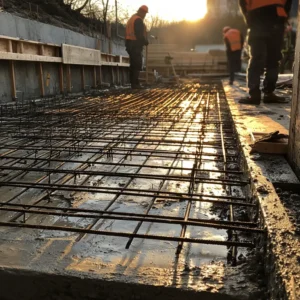Cracks in concrete are a builder’s nightmare. Weak spots in a slab can turn into costly repairs down the road. As a builder, you’re faced with a tough decision: should you go with traditional rebar or the modern fiber mesh for reinforcement? The answer isn’t straightforward, but it’s critical for the success of your project.
Rebar and fiber mesh both reinforce concrete, but they serve different purposes. Rebar adds tensile strength and is best for load-bearing structures. Fiber mesh, on the other hand, distributes stress and minimizes shrinkage cracks. The best choice depends on your project’s needs.
Still undecided? Don’t worry. Let me break it down for you, the Fiberego way.
What Are Rebar and Fiber Mesh?
1. What is rebar?
Rebar, short for reinforcing bar, is made of steel and placed in concrete to provide tensile strength. It’s commonly used in heavy-load structures like bridges and high-rise buildings.
2. What is fiber mesh?
Fiber mesh consists of synthetic, steel, or glass fibers mixed into the concrete. These fibers distribute stress evenly, minimizing cracks and enhancing durability.

Comparing Rebar and Fiber Mesh: Which Wins?
Strength
Rebar is king when it comes to tensile strength. It works wonders for large-scale, load-bearing structures. Fiber mesh, however, provides all-around crack resistance by evenly distributing stress.
Durability
Fiber mesh enhances the durability of concrete by resisting shrinkage and thermal cracking. Rebar focuses on structural strength but may require additional protection from corrosion.

Cost
Rebar is often more expensive to install due to labor and material costs. Fiber mesh, though more cost-effective upfront, might not replace rebar for heavy-duty projects.
Questions to Ask Before Choosing
1. What’s the purpose of your structure?
For load-bearing elements like beams and columns, rebar is your best bet. Fiber mesh works better for slabs, sidewalks, and driveways.
2. What’s your budget?
Rebar installation involves higher labor costs, while fiber mesh is mixed directly into the concrete, saving time and money.

3. How important is crack resistance?
Fiber mesh excels at reducing shrinkage cracks, making it ideal for flatwork like floors and parking lots. Rebar may not prevent cracking but strengthens the structure overall.
4. Is corrosion a concern?
If you’re working in a corrosive environment, fiber mesh offers an edge as it doesn’t rust like rebar. However, corrosion-resistant rebar options are available.
When to Use Rebar
Heavy Loads
Rebar is ideal for structures that bear heavy loads, such as columns, beams, and retaining walls. It adds the tensile strength needed to prevent structural failure.
Long-Span Structures
For bridges or long spans, rebar provides the necessary support to handle compression and tension forces.

When to Use Fiber Mesh
Slabs and Floors
Fiber mesh minimizes shrinkage cracks and improves durability in flat surfaces like floors, patios, and driveways.
Quick Projects
For smaller projects with tight timelines, fiber mesh is easier and faster to integrate than rebar.

Frequently Asked Questions About Concrete Reinforcement
1. Can fiber mesh replace rebar entirely?
In some cases, yes. Fiber mesh can replace rebar in non-load-bearing applications but isn’t suitable for high-stress structures.
2. Does rebar prevent cracks?
Rebar reinforces concrete but doesn’t prevent surface cracks. That’s where fiber mesh comes in.
3. How is fiber mesh mixed into concrete?
It’s added directly to the concrete mix and evenly distributed throughout the slab.
4. Is fiber mesh cost-effective?
Yes, especially for projects requiring reduced labor and fast installation.
5. Are there hybrid solutions?
Absolutely! Combining rebar and fiber mesh offers the best of both worlds for certain projects.
Why Choose Fiberego?
At Fiberego, we specialize in high-quality fiber solutions that transform concrete. Our fiber mesh products are designed for durability, crack resistance, and ease of use. Whether you’re building a driveway or a skyscraper, we’ve got you covered.
What sets us apart:
- Custom solutionstailored to your project.
- Expert guidancefrom industry professionals.
- Sustainabilitythrough innovative materials.
Curious about how fiber mesh can enhance your next project? Let’s chat.

Conclusion
So, what’s the verdict? Rebar and fiber mesh each have their strengths. Rebar is the go-to for load-bearing, heavy-duty structures, while fiber mesh excels at crack resistance and cost efficiency in flatwork. The best choice depends on your project’s specific needs.
At Fiberego, we’re here to help you make the right decision. Let’s build stronger, smarter, and more sustainable structures together.



